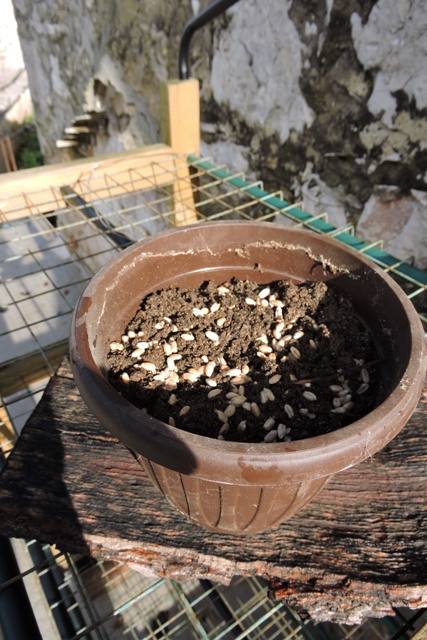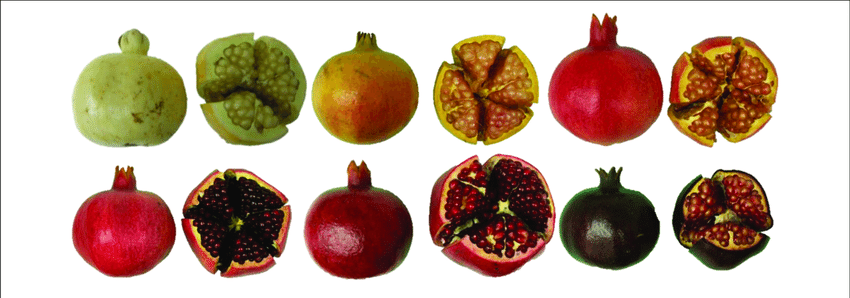This week’s riddle
This week: This week’s riddle; Two’s company; Absentee neighbours; Digging out thorns; It’s great being a grower; Replacement required;

The start of the week has been a 100 mile an hour ride to complete all the different jobs. But that was only until Wednesday, when it started raining.
I had looked ahead at the weekend and saw there there was likely to be some prolonged rain. Although Monday and Tuesday were likely to be fine, sunny days.

My weather station forecast for the week was that we would have rain from early on Wednesday. Probably lots of rain, but in advance of the rain, there were also some cold, clear nights.
So I decided to do as much as I could, while it was fine, knowing that the there would be little outside work possible from Wednesday.
On Tuesday morning there was more radiation frost on some ground plants, but still no real frost yet.

Suddenly this week the leaves of my Flowering Cherry in the courtyard have changed to gold and started to fall.

This is a Prunus Serullata Amanogawa, which is a slow growing columnar flowering cherry. I planted it because of the masses of fragrant pink blossom in the spring and the beautiful autumn colours.

Although at this time of year it does not get any sun, the leaves have really put on a nice show this week.
This week’s riddle
This is one of those jobs I have been going to do for a while, but the conditions have not been right.
I need to dig out round the new workshop for an all weather path. This area was the old fold yard. So decades of animals of various kinds reliving themselves, means that it has the best soil of any on my land.
There is a drawback though. Like all my soils, between a quarter and a third by volume is stone.
It would be easy to simply dig it out, load it on a truck and cart the soil and stones off to the tip.
Never being one to do things in a straightforward way, and because of not having enough good quality soil on my land, I decided I would dig the soil out and riddle it. This meant I could then save the soil and use the stone as the foundations for the path.
I began this project in September, when the daytime temperature had made outside work pleasant once more. But after a dry summer, even just riddling soil by hand created too much dust. This was because that was all the soil was, so I gave up.
Then came the September rains, followed by more rain in October. However after a dry November, the soil was absolutely at its best for riddling to separate the stones from the soil.
On Tuesday morning I set up my Scheppach rotary riddle and started to dig. This is one of those machines that you don’t use very often, but it is worth its weight in gold when you do use it.

It is electric and almost silent.
Using a shovel you throw a shovel-full of soil into the front and the rotating action filters the soil through an adjustable mesh into the wheelbarrow below. Small stones, big stones, vegetation, in fact everything which cannot pass through the adjustable mesh holes, is expelled out of the back.

I couldn’t keep up with the machine. I had to keep stopping the riddle so I could use a pick axe to break up the soil and stones where the path will go and then start it again and work through the softened material with the shovel.
At the end of the day, I have cleared about a half cubic metre of soil and stones. But the soil does need to be the right consistency: too dry and all you get is clouds of dust, and too wet and it will not easily pass through the riddle.
I had guessed correctly and the conditiones were just right on Tuesday, before the rains started…
Two’s company
Two’s company, three’s a crowd and four is just impossible!
The weather forecast has been spot on this week. We have had rain every day since before dawn on Wednesday, with a total of 71.6 mm up to tea time on Saturday.
Thursday dawned overcast but dry, so before breakfast I brought several loads of firewood up from the wood store in the orchard, to the summer kitchen store. This small wood store is close to the dining room. So I can collect dry wood from there without getting soaked every time when it rains.
The rain started at 10am, just in time for coffee. I had the lights on inside almost all the rest of the day on Thursday.
Around 11am, with an ever darkening sky, I heard the first claps of thunder so had a look at the weather radar. There was a 100 kilometre line of thunderstorms stretching from south of the island of Viz, north to Split and over the west of Hvar.

From the study I could hear the rain beating down on the greenhouse roof and I wondered where the kittens were?
They had joined my No. 2 cat Gizmo in his bed on the greenhouse staging. Although three growing kittens does not leave much room for a young adult cat – especially one who likes his food, and he was complaining bitterly about the crowd.

When I looked in later, he had decamped to the very top shelf, where the kittens can’t yet reach. It’s a good job I cleaned all the shelving in the greenhouse out last week!
The rain continued all day. By early afternoon the separate storm cells had merged into one long thunderstorm, which was moving slowly east and was lying over the top of Dol.

I was expecting the usual lightning strike to cut all power, so went round switching all unnecessary electrics off. I needn’t have worried as we had no power outages, but the rain continued until bed time.
When I looked in on the felines, they were all curled up asleep together.
Given that Gizmo is a year and a half old (and is male) he has really taken to the kittens. They play together and he plays really nicely with them.
You read that male cats will often kill male kittens because they view them as competition and are jealous.
The kittens follow him around, pull his tail, jump on him and he just takes everything in his stride.
He has earned the title Ujko Gizmo – Uncle Gizmo in Croatian.
Absentee neighbours
My immediate neighbour to the east is an absentee. Although he only lives down the hill in Stari Grad, I have not seen him here in over 12 months.
He is a blood relative of the Roić brothers who originally built my home, in the 19th century. Property ownership records do not go back far enough to say how long the family have lived here, but it has been a substantial length of time.

This owner has two buildings outside my gates, one of which is attached to my Konoba. I am told that it is more than forty years since anyone lived in them.
The free-standing Konoba on the ground floor of the building is used as storage for olive vats. However it is probably only rats who inhabit the place now. The roof steadily sags more as times passes and rain water runs down the outside walls.
The “garden” – I use the term loosely – which adjoins my citrus orchard has gone back to wild grasses and weeds. On my boundary is a pomegranate tree which is now thick with multiple suckers and festooned with briars.

Many of these long trailing briars overhang my boundary. The green leaves by the way, are not weeds. They are next year’s Madonna Lilies, which I have planted all together, between citrus trees, in a single stand.
With the likelihood of cold, I needed to get the wind protection netting around the two closest citrus trees. These are an orange and a grapefruit tree, but the hanging briar fronds made it impossible to get in to work there and the thorns would snag the netting too.
So on Monday I started to cut back the overhanging thicket, so I could at least see the boundary stones.
Digging out thorns
It is nine months since I was last in this area of the orchard. That was when I removed the protective mesh in the spring.

I was really surprised by just just how thick the ‘accidental’ hedge on the boundary had become this past summer. A season’s worth of growth has made an almost impenetrable barrier.
That has distinct benefits, because it stops a lot of the wind borne weed seeds blowing into my orchard.
Its thickness and foliage density provides a lot of protection on my side, against the cold east and north east winds. It will also be a haven for insects and wildlife.

With thick gloves, secateurs, hedging shears, brush cutters and a long handled pruner to reach into the pomegranate, I started to cut back the overhang.
Some bits were easy, others parts, especially where there were blackberry briars more than 25mm in diameter, were less so.
I decided that I actually like the idea of the windbreak produced by the hedging thicket. So rather than just cut everything off at soil level, I cut back vertically to just beyond the boundary, but left the thicket intact.
I did cut the briars off at their base though, but leaving the runners intact, entwined in the tree. They will grown new shoots in the spring, but digging out the thorn laden briars, entwined as they are in the roots of the tree would be impossible.
With everything cut back I was able to access the steel cages around the two citrus trees and fix the netting screen in place.

When I finished and I removed my gloves, I realised that some of the surgical needle sharp thorns had penetrated through the thick gloves I had been wearing.
I used a small scalpel blade, under an illuminated desk magnifier to remove the tips of the thorns which were embedded in my flesh. This was followed by an application of antiseptic.
Finally on Saturday morning, after feeling another irritant in my thumb, I dug out the last thorn. A thorn I hadn’t noticed, or felt, earlier in the week.
It’s great being a grower
Heavy rain around 3am on Friday woke me, but it wasn’t difficult to slip under the quilt and drift off back to sleep, that is until winter getting up time at 7am.
The rain had stopped and it was mild outside. One advantage of rain coming from the south at this time of year is that it is warm, and a southerly airflow even when dry, is also warm.
The 4th December is St. Barbara’s day, so I planted a round pot with the Božićna pšenica – the Christmas Wheat – then put it into the propagator in the greenhouse, where it is warm and light.

As the sun came out, I decided to chance cutting down an old pomegranate tree which is growing tight against the wall of the cottage.
Its leaves fill the gutters and fallen fruit make a mess on the terrace.

I already have three other pomegranate trees and this one has had few fruits on it. The tree also keeps light off one of the lemon trees and a lime tree in the citrus orchard.
One pomegranate tree in particular provides extremely sweet fruits, but the trees are all quite old and are just standard local trees rather than a modern named variety.
Eastern Mediterranean countries are known for their production of pomegranates and for the different varieties. When ripe, the arils (the edible seeds) and the outer peel can vary in colour from green to black.

Pomegranate wood is not very strong, so branches tend to split and break quite easily when they get too big or are weighed down by heavy fruits.
The trees also produce huge numbers of suckers from the base of the tree.

Their foliage in autumn is nice, but because of sharp spines you need thick gloves to prune them. This tree has been left to grow wild and has not been pruned for years so has grown completely out of hand.
Starting with the small suckers, I cut back to the point here I could access the multiple thick trunks. Using the chain saw I cut the first thick trunk. Its centre was black in the middle, so the tree is obviously diseased.
Everything that I have cut down will be used. The thinner branches will be shredded to make mulch and the thick branches and trunks will be left to dry throughout next summer. Then they can be used for fuel next winter.
I removed all the remains to an area where I can process them later.
Most of the leaves have come off and I’ll leave them on the ground to rot down and improve the very poor quality soil in this area.
After I cut down all the top growth, what I was left with were three quite substantial trunks. I’ve cut them off about 1 meter above the ground, because I will need to try and get the stump out of the ground.

That is not going to be easy, so I have left enough trunk exposed to attach a chain to and then I will dig around the base and try and lever as much of the bowl of the tree out as I can using a hand winch.
The problem being that every bit that I leave will potentially grow into a new tree.
It lets a lot more light into the terrace and patio.

Replacement required
I have several nice young fruit trees in the nursery, waiting for a permanent place for them to be prepared. But what should I replace this pomegranate with?
It really depends whether I want to put an ornamental tree there, something like a Witch hazel
or one of the fruiting trees.
I’m leaning towards planting a Jujube, Ziziphus jujuba. In Dalmatia, the fruits from the Jujube trees are used to make a sweet preserve or in a fruit brandy.
The Jujube likes full sun, tolerates drought and poor soil, so this orchard would be ideal. The other alternative is a sweet cherry, but I think I’ll plant that in the top orchard where the conditions are better.
Just as I was clearing the tools away on Friday afternoon, the rain started again. So I decided that the selection of the replacement for the old pomegranate can be left for another day. NCG
4 Responses
John Bailey
Once again Norman a very interesting read. Electric Riddle must save a lot of hard work. I only have a hand driven one that you crank round.
Marcy
Great read. I learn so much and love seeing you home. Thanks for sharing as always. Marcy
Elizabeth Blackledge
Fascinating read Norman. Glad you are still busy digging and riddling…I only have a sieve! Stay well and warm x
Brian Honans
Very interesting to see the revolving riddle – never heard of such a thing before!